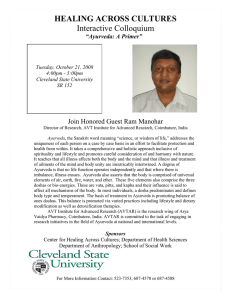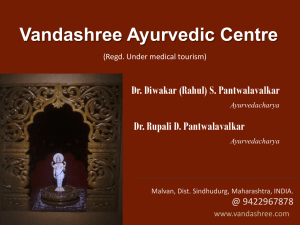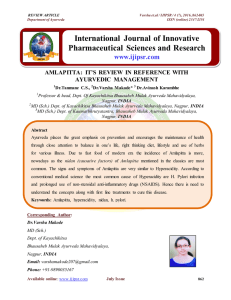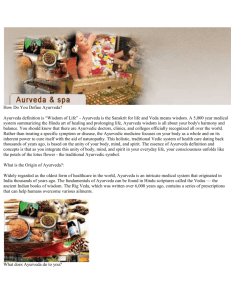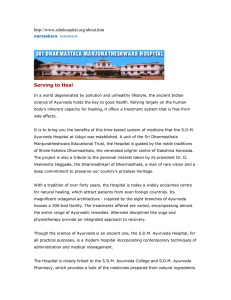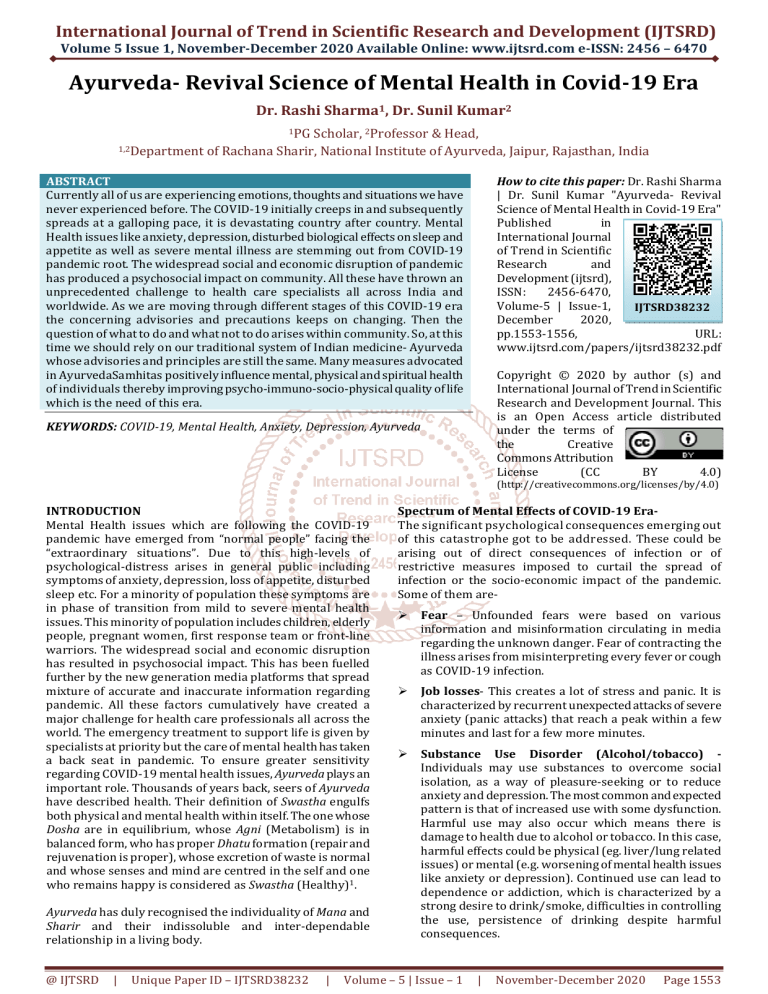
International Journal of Trend in Scientific Research and Development (IJTSRD) Volume 5 Issue 1, November-December 2020 Available Online: www.ijtsrd.com e-ISSN: 2456 – 6470 Ayurveda- Revival Science of Mental Health in Covid-19 Era Dr. Rashi Sharma1, Dr. Sunil Kumar2 1PG Scholar, 2Professor & Head, 1,2Department of Rachana Sharir, National Institute of Ayurveda, Jaipur, Rajasthan, India How to cite this paper: Dr. Rashi Sharma | Dr. Sunil Kumar "Ayurveda- Revival Science of Mental Health in Covid-19 Era" Published in International Journal of Trend in Scientific Research and Development (ijtsrd), ISSN: 2456-6470, Volume-5 | Issue-1, IJTSRD38232 December 2020, pp.1553-1556, URL: www.ijtsrd.com/papers/ijtsrd38232.pdf ABSTRACT Currently all of us are experiencing emotions, thoughts and situations we have never experienced before. The COVID-19 initially creeps in and subsequently spreads at a galloping pace, it is devastating country after country. Mental Health issues like anxiety, depression, disturbed biological effects on sleep and appetite as well as severe mental illness are stemming out from COVID-19 pandemic root. The widespread social and economic disruption of pandemic has produced a psychosocial impact on community. All these have thrown an unprecedented challenge to health care specialists all across India and worldwide. As we are moving through different stages of this COVID-19 era the concerning advisories and precautions keeps on changing. Then the question of what to do and what not to do arises within community. So, at this time we should rely on our traditional system of Indian medicine- Ayurveda whose advisories and principles are still the same. Many measures advocated in AyurvedaSamhitas positively influence mental, physical and spiritual health of individuals thereby improving psycho-immuno-socio-physical quality of life which is the need of this era. Copyright © 2020 by author (s) and International Journal of Trend in Scientific Research and Development Journal. This is an Open Access article distributed under the terms of the Creative Commons Attribution License (CC BY 4.0) KEYWORDS: COVID-19, Mental Health, Anxiety, Depression, Ayurveda (http://creativecommons.org/licenses/by/4.0) INTRODUCTION Mental Health issues which are following the COVID-19 pandemic have emerged from “normal people” facing the “extraordinary situations”. Due to this high-levels of psychological-distress arises in general public including symptoms of anxiety, depression, loss of appetite, disturbed sleep etc. For a minority of population these symptoms are in phase of transition from mild to severe mental health issues. This minority of population includes children, elderly people, pregnant women, first response team or front-line warriors. The widespread social and economic disruption has resulted in psychosocial impact. This has been fuelled further by the new generation media platforms that spread mixture of accurate and inaccurate information regarding pandemic. All these factors cumulatively have created a major challenge for health care professionals all across the world. The emergency treatment to support life is given by specialists at priority but the care of mental health has taken a back seat in pandemic. To ensure greater sensitivity regarding COVID-19 mental health issues, Ayurveda plays an important role. Thousands of years back, seers of Ayurveda have described health. Their definition of Swastha engulfs both physical and mental health within itself. The one whose Dosha are in equilibrium, whose Agni (Metabolism) is in balanced form, who has proper Dhatu formation (repair and rejuvenation is proper), whose excretion of waste is normal and whose senses and mind are centred in the self and one who remains happy is considered as Swastha (Healthy)1. Ayurveda has duly recognised the individuality of Mana and Sharir and their indissoluble and inter-dependable relationship in a living body. @ IJTSRD | Unique Paper ID – IJTSRD38232 | Spectrum of Mental Effects of COVID-19 EraThe significant psychological consequences emerging out of this catastrophe got to be addressed. These could be arising out of direct consequences of infection or of restrictive measures imposed to curtail the spread of infection or the socio-economic impact of the pandemic. Some of them areFear – Unfounded fears were based on various information and misinformation circulating in media regarding the unknown danger. Fear of contracting the illness arises from misinterpreting every fever or cough as COVID-19 infection. Job losses- This creates a lot of stress and panic. It is characterized by recurrent unexpected attacks of severe anxiety (panic attacks) that reach a peak within a few minutes and last for a few more minutes. Substance Use Disorder (Alcohol/tobacco) Individuals may use substances to overcome social isolation, as a way of pleasure-seeking or to reduce anxiety and depression. The most common and expected pattern is that of increased use with some dysfunction. Harmful use may also occur which means there is damage to health due to alcohol or tobacco. In this case, harmful effects could be physical (eg. liver/lung related issues) or mental (e.g. worsening of mental health issues like anxiety or depression). Continued use can lead to dependence or addiction, which is characterized by a strong desire to drink/smoke, difficulties in controlling the use, persistence of drinking despite harmful consequences. Volume – 5 | Issue – 1 | November-December 2020 Page 1553 International Journal of Trend in Scientific Research and Development (IJTSRD) @ www.ijtsrd.com eISSN: 2456-6470 • • • • • • • • Economic clash-down- Financial stress leads to depression with following symptomsLow mood Decreased or loss of capacity to enjoy things Decreased energy Marked tiredness after even minimum effort (not due to any medical cause including COVID-19) Reduction in activity or feeling restless Lowered attention/ concentration- complaints of poor memory Feeling of helplessness and that there is no hope for the future. Death wishes, suicidal thoughts or attempts Lockdown Effects- this causes long separation of families especially for those working away from their hometowns which causes boredom, mood swings, anger, irritation and frustration. Effects on Children and Elderly People- Worries of adults are transmitted to children and elderly people. As a result, they become more anxious and fearful. Due to lack of socialisation and outdoor activities, their dependency on social media and online entertainment increase which can make children more isolated thereafter and elderly more left-out. Acharya Charak has also described different types of ferocious mental urges which need to be controlled else would lead to severe mental diseases. They are mentioned under the heading “Dharniya vega” as Lobha (Greed), Shok (Mourning), Bhaya (Fear), Krodh (Anger), Maan (Ahankaar) (Ego), Nirlajjata (Shamelessness), Irshya (Envy), Atiraag (Extremely passionate), Abhidhya (Wish).6Now-a-days these are considered as a part of social medicine for mental health. Achara Rasayana is mentioned in Ancient Indian medical treatise giving importance to rejuvenation therapies. For better action of rejuvenating therapy, one has to undergo prior purification of mind as well as body. Achara Rasayana7are basically rejuvenating attitudes that one should incorporate in one’s own life. Few mentioned in our Samhitas areSatya Vadhi – Being truthful Akrodha – Being free from anger Madya maithuna nivrutham – avoiding alcohol and practicing celibacy Ahimsa – non-violence in thought, word and action Anayasam – avoiding excessive over thinking, stress and worry Prashantha – Indulging in creative activities Effects on Pregnant women- They can have a host of concerns from going out for ante-natal examination to negative thoughts regarding future and unborn child. Priyavadhinam – Speaking sweetly Stigma attached with COVID-19- There are several instances of people in quarantine being isolated from the society and cruel societal response to people with a diagnosis of COVID-19. Saucha Param – maintaining good personal hygiene Dheeram – Having the self-confidence to maintain stable thoughts, and being courageous in actions Effects on Health Care Professionals- Due to their over engagement in COVID care the worries about adequacy of their own protection, taking infection to their families, long working hours, improper food and rest leads to severe psychological distress. Thapasvinam – Meditation and self-analysis Role of Ayurveda in Reviving the Mental Health in COVID-19 EraConventional mainstream medicine is at the forefront when it comes to curbing this menace physically, especially at the critical care stage but Ayurveda has considered “Ayu” as fourdimensional aspect comprising Physical, Sensorial, Mental and Spiritual.2Human being is combination of mind, soul and body. These three entities sustainthe world like a tripod.3 Research and therapeutic strategies for COVID-19 have focused on agents to attack the virus or immunize against it. This leaves aside the consideration of the host’s mental status—one of the most important factors in disease dynamics. Ayurveda pays particular attention to the host’s mental well-being and recommends measures for a healthy lifestyle rather than the mere prescription of medicine. Three entities of mind are Sattva, Rajas, Tamas. It is clearly mentioned in Ayurveda Samhitas that both Rajas and Tamas are the causative factors for mental disorders.4When there is a balance in functioning of Sattva, Rajas and Tamas, the mental health is perfect but if a person does Pragyaapraadh it will ultimately cause psychological imbalance and thereby mental illness and Pragyaapraadh is considered as a basic factor (yoni) of Janpadodhwansa.5 @ IJTSRD | Unique Paper ID – IJTSRD38232 | Japa – maintaining spiritual practices Dananithnam – Being involved in charitable work, or giving to others Deva Go Brahmana Acharya GuravridharchaneRatham – Paying respects to the divine or God, to cows, teachers, and older people Nithya Anrshshasyaparam – avoiding ‘barbaric’ and aggressive behaviour Sama Jagaranaswapnam – Maintaining regular waking and sleeping rhythms Nithya Sheeraghrithaashinam – Caring for the body with nourishing foods Deshakalapramana – possessing the knowledge of which actions are appropriate according to the space and time YuktiJnanam – The wisdom to know what is good for you and what is not Anahakretam – Being free from ego – driven actions Shasta Achara – Acting with dignity and respect Asamkeernam – Being open-minded If a person practices Achara Rasayana then he will be bestowed with all effects of mental rejuvenation therapy. Description of right mental and physical conduct is very much essential at the time of pandemic and is beautifully described byseers of Ayurveda in form of Sadvritta.8 It helps Volume – 5 | Issue – 1 | November-December 2020 Page 1554 International Journal of Trend in Scientific Research and Development (IJTSRD) @ www.ijtsrd.com eISSN: 2456-6470 in creating appropriate influence of environmental and social factors on oneself and a proper interaction of mind and body thereby, enhancing Sattva Guna overRajas and Tamas leading to good mental health. The psychological factors that are described in Charak Samhita shows high involvement in mental diseases during pandemic. They are- Mana (mood, emotion); Buddhi (thought process); Sangyagyaan (orientation); Smriti (memory); Bhakti (desire); Sheel (habits); Cheshta (psychomotor function); Achara (conduct and behaviour).9 Acharya Charak has described immunity as the ability to prevent disease and arrest its progress to maintain homeostasis.The concept of building strength of mind and body to cope with various stressors, including infection, is a bedrock of Ayurveda practice. Yoga nidra or yogic sleep is a state of consciousness between waking and sleeping, like the "going-to-sleep" stage, typically induced by a guided meditation. There is evidence that yoga nidra helps relieve stress. Yoga nidra is a state in which the body is completely relaxed, and the practitioner becomes systematically and increasingly aware of the inner world by following a set of verbal instructions. In yoga nidra the practitioner remains in a state of light withdrawal of the 5 senses (pratyahara) with four senses internalised, that is, withdrawn, and only hearing still connects to any instructions given. It is among the deepest possible states of relaxation while still maintaining full consciousness10. Poor mental health conditions during Pandemic including stress, anxiety and depression increases the risk of acute respiratory infections.11 In such cases, measures like Pranayaam and Meditation have shown cosmic results. Pranayaam has shown improvement in lung function ability. Meditation is found to influence substantially the markers of virus specific immune response.12Ayurveda psychotherapy popularly known asSatvavajaya13refers to psychological and psychodynamic methods to divert the psyche of an individual towards wholesome objects which is very essential in COVID-19 era. This helps in the refurbishment of normal state of various psychological factors like intelligence, memory etc. It is practised by assimilating the principles of Assurance therapy (Ashvasana) along with substitution of emotions like anger by composure, greed by content, ignorance by knowledge, jealousy by affection etc. DiscussionThe factors mentioned in Spectrum of COVID-19 era ultimately leads to stress,anxiety and depression in individuals. In Psychoneuroimmunology, there is an intimate link between the nervous system, endocrine system and immune system and it explains the mechanics behind the modulation of immune response to infection by stress and emotional disorders (Kim and Su 2020).14Daily practice of Yoga and meditation has influence psychoneuroimmunology via modulation of stress responses, monoamine function and parasympathetic activity. Yoga has been shown to stabilize the response of the nervous system to stress, removing the constant muscular tension produced by repeated alerts from the CNS and calming the involuntary symptoms of threatracing heart, anxiety- roused by sympathetic nervous system.15By following Ayurveda guidelines regarding Swasthavritta and Sadvritta, a relaxation response can be @ IJTSRD | Unique Paper ID – IJTSRD38232 | induced. By learning to induce a relaxation response, subjects can modify the way in which stressful events affect the sympathetic nervous system. Studies suggest that the relaxation response decreases the bodies response to nor epinephrine (Soliman, Schmidt and Adragna 1980). By the practice of Pranayama,the respiratory centre in the medulla oblongata is brought under violation- there is improvement in functioning of vasomotor mechanism. Thereby, helping in breathing difficulties arise due to COVID along with modulation of stress response. Hence Ayurveda is quite effective in reviving the mental health during COVID19 era. ConclusionPeople are overstressed, depressed and anxious by the compulsions of social distancing, lockdown, economical breakdown and bleak future due to increase in number of cases. They are likelyto find comfort and support in some of the deeply rooted traditional practices that may protect them from the infection and its associated debilitating mental conditions. Remarkably, measures mentioned in Ayurveda for mental well-being have the advantages of simplicity, affordability, and acceptability and appear promising as feasible measures for large-scale implementation. Thus, Ayurveda plays a potential role in engaging the community in creating a more positive and more mentally strong environment to cope with COVID-19. References[1] Vaidya Priyavrat Singh, Sushruta Samhita, Editor: Laxmishankarvishwanathguru, Chaukhamba Sanskrit Sansthan,Varanasi; 6th edition; Sutra sthana 15/41. [2] Pt. Kashinath Shastri, Dr Gorakhnathchaturvedi, Charak Samhita, vol 1, Editor: Pt. Rajeshwardutta shastri, Chaukhamba Orientalia, Varanasi 2013, Sutra sthana 1/42. pg.13. [3] Pt. Kashinath Shastri, Dr Gorakhnathchaturvedi, Charak Samhita, vol 1, Editor: Pt. Rajeshwardutta shastri, Chaukhamba Orientalia, Varanasi 2013, Sutra sthana 1/46. Pg.18. [4] Pt. Kashinath Shastri, Dr Gorakhnathchaturvedi, Charak Samhita, vol 1, Editor: Pt. Rajeshwardutta shastri, Chaukhamba Orientalia, Varanasi 2013, Sutra sthana 1/57. Pg.32. [5] Pt. Kashinath Shastri, Dr Gorakhnathchaturvedi, Charak Samhita, vol 1, Editor: Pt. Rajeshwardutta shastri, Chaukhamba Orientalia, Varanasi 2013, Vimansthana 3/20. pg.695. [6] Pt. Kashinath Shastri, Dr Gorakhnathchaturvedi, Charak Samhita, vol 1, Editor: Pt. Rajeshwardutta shastri, Chaukhamba Orientalia, Varanasi 2013, Sutra sthana 7/27. Pg.160. [7] Agnivesa"sCharakSamhita text with English translation & critical Exposition based on Ayurved Dipika By Dr Ram Karan Sharma and Vaidya Bhagwan Dash publisher chaukhambasanskrit series office, varanasi-1, edition CharakChikitsaSthan 1-4/30-35, 2004; 3:63. [8] Pt. Kashinath Shastri, Dr Gorakhnathchaturvedi, Charak Samhita, vol 1, Editor: Pt. Rajeshwardutta Volume – 5 | Issue – 1 | November-December 2020 Page 1555 International Journal of Trend in Scientific Research and Development (IJTSRD) @ www.ijtsrd.com eISSN: 2456-6470 shastri, Chaukhamba Orientalia, Varanasi 2013, Sutra sthana 8/17. Pg.181. [9] [10] [11] [12] Mehta Anil K, Sharma Raghunandan; Ayurveda Physiotherapy and Yoga; Publ: Chaukhamba Sanskrit Pratishthan; 2010, ISBN: 81-7084-432-1. Pg.66. [13] Ross, Gillian (23 July 2009). "Yoga nidra: deep relaxation practice". ABC. Archived from the original on 29 July 2009. Retrieved 12 April 2019. Shastri Kashinath, Chaturvedi Gorakhnath edited Charak Samhita of Agnivesha, Revised by Charak and Dridhabala, Part I, Chaukhamba Bharati Academy, Varanasi, Reprint., 2004; Sutra Sthana 11/54: P-238. [14] Pedersen, A., Zachariae, R., Bovbjerg, D.B., 2010. Influence of psychological stress on upper respiratory infection – a meta-analysis of prospective studies. Psychosom. Med. 72, 823–832. https://doi.org/10.1097/PSY.0b013e3181f1d003. Kim, S.W., Su, K. P., 2020. Using psychoneuroimmunity against COVID-19. Brain, Behavior Immun. (in press). doi: 10.1016/j.bbi.2020.03.025. [15] Mehta Anil K, Sharma Raghunandan; Ayurveda Physiotherapy and Yoga; Publ: Chaukhamba Sanskrit Pratishthan; 2010, ISBN: 81-7084-432-1. Pg.63. Pt. Kashinath Shastri, Dr Gorakhnathchaturvedi, Charak Samhita, vol 1, Editor: Pt. Rajeshwardutta shastri, Chaukhamba Orientalia, Varanasi 2013, Nidansthana 7/5. pg.656. @ IJTSRD | Unique Paper ID – IJTSRD38232 | Volume – 5 | Issue – 1 | November-December 2020 Page 1556
